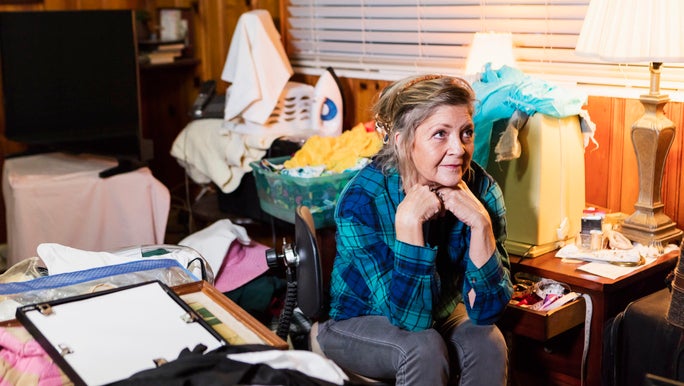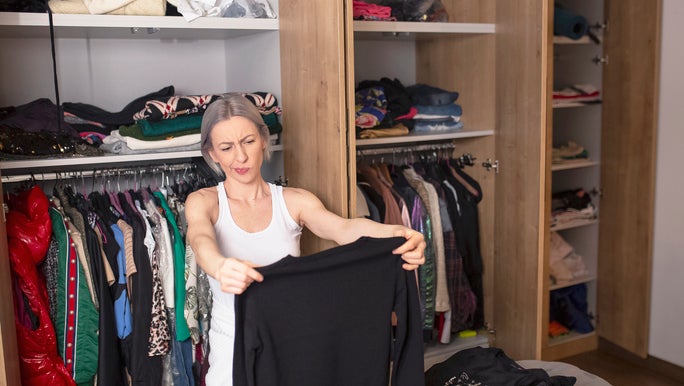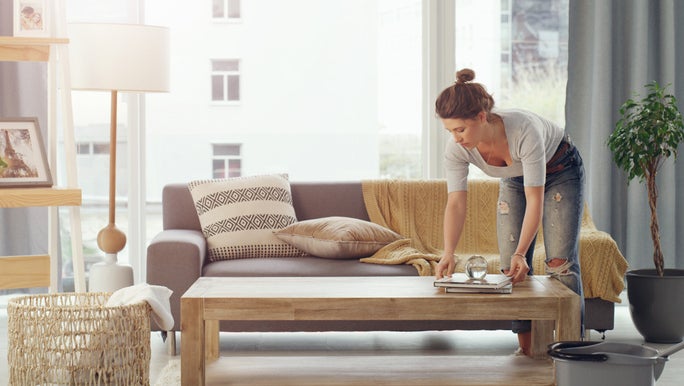Key Points
- Science shows clutter may increase cognitive overload and create stress.
- Have a plan in place for which areas of the house to declutter first.
- Create four categories: ‘keep’, ‘store’, ‘donate’ and ‘throw away’.
If a cluttered house is driving you nuts, it’s time to take action. Clutter can add to your mental load and create undue stress when what you crave is a Zen-like abode of calm, peace and order.
It’s easy to put off decluttering because it’s not as immediately pressing as daily household chores. But setting aside some time now to clear out the possessions you’ve accumulated that no longer add value to your life will pay off long into the future.
What does decluttering mean?
Decluttering means clearing out unnecessary or unused items to create a more harmonious and organised living space. It not only enhances aesthetics but evidence also shows it may have mental health and cognitive benefits, as mentioned above.
Whether you’re a ruthless declutter warrior who takes no prisoners or someone who always keeps a box of miscellaneous items ‘just in case’, the upshot is that any level of decluttering can help you feel lighter and more productive. With all the superfluous junk gone, you’ll feel a renewed sense of peace in your home.
Are there benefits to decluttering?
Decluttering is more than just your garden-variety housework. It’s an act of self-care that’s about ordering and beautifying your inner sanctum. And it’s not just about throwing things away, either. There’s an art to it, requiring careful consideration, thoughtful planning and a willingness to let go of what no longer serves you.
By releasing possessions you no longer use or that don’t bring you joy, you create space for more of what truly matters – and that doesn’t mean more possessions! Having a good clean-out and creating more space brings a sense of calm and order to your home. And who doesn’t want more of that?
Research shows clutter may negatively impact brain functioning and be a source of stress. So decluttering isn’t just an art – it’s also a way to care for your mental wellbeing that’s somewhat backed by science.
One study revealed clutter could contribute to reduced visual working memory in some people. This is our brain’s temporary storage system of information about objects in our surrounding environments. The visual distraction of clutter affects our visual working memories and can increase cognitive overload, a state where your brain feels fried from too much information or stimulation.
Another study found disorganisation and clutter can have a cumulative negative effect on the brain, while this study found women who described their homes as cluttered were more likely to feel fatigued and stressed than women who described their homes as orderly.

Decide whether to tackle the messiest rooms first or start small and work your way up
Declutter your home checklist: a room-by-room guide
You may prefer to tackle the largest, messiest rooms first or start small with a wardrobe and work your way up. Either way, decide on a strategy before you begin. As you move through the house, you’ll most likely find items strewn in random places.
Keep in mind an old saying, often attributed to Benjamin Franklin: “A place for everything, everything in its place”. It’s a helpful motto to repeat as you embark on your decluttering mission.
A tried-and-tested method for categorising your possessions is to have four large boxes: one for items you want to keep out for regular use, one for items you want to pack away into storage, one for donations and one for items you will throw away.
So put on your favourite podcast or the beats that get you going, and get started. Or better yet, get the whole family involved and make it a household project!
The entryway
This is a good place to begin, as it’s at the front of your home, and it’s the area everyone sees first.
Clear away any items that don’t belong there, then survey the scene. Add some hooks or buy a coat rack if you need somewhere to hang your garments. You may also like to add small shelves for shoes and baskets for umbrellas.
If you’re always losing your keys, place an attractive catchall near the entryway, and get into the habit of dropping your keys into it when you arrive home.
The living room
Begin with a sweep of the area, picking up discarded items and returning them to where they belong.
Next, clear the coffee table. We tend to dump anything and everything on the trusty coffee table, but an uncluttered coffee table is essential for an orderly living room.
Next, go fishing behind the couch cushions for lost items. If you have bulging bookshelves or magazine racks, consider donating those still in good condition. If your living room is filled with ornaments and knick-knacks, be honest about which ones you really love and which ones you can re-home.
The kitchen
Declutter the pantry by first discarding out-of-date food, then categorising the shelves into zones according to what each ingredient is used for, e.g., baking, quick meals, lunches, staples. If the shelves are overflowing with tins, packets and storage containers, add some boxes or split shelves to help you organise it all.
As you go through each cupboard in the kitchen, discard broken or chipped crockery or glassware, move rarely used appliances to a top shelf, or get rid of appliances you no longer use.
The bathroom
Makeup and skincare products often have short expiry dates, so begin by discarding expired products. Add any grooming tools you haven’t used in a year to your donation box, and add shelves, storage units and hooks to help keep things organised.
The bedrooms
Begin by making the bed – it makes the room feel tidier straight away. Then remove clothes from the ‘floordrobe’, and either place them in the laundry basket or store them in your wardrobe. If your wardrobe is a nightmare, consider allocating time on a separate day just for this task, as decluttering clothes can take longer than expected.
Clear your bedside tables and only replace essentials such as a reading lamp, books and items you regularly reach for when you’re in bed.
The laundry
It’s one of the smaller rooms in your home, but it often ends up being the unofficial dumping ground for sundry items.
Begin by removing anything from the laundry unrelated to washing and drying your clothes. Discard empty laundry detergent containers, old sponges and single socks waiting around for their long-lost matching pair.
Store any products you rarely use on higher shelves and move the more commonly used items to the most accessible areas. Consider adding three laundry baskets for whites, light colours and colours.
The linen closet
Begin by discarding any old and threadbare towels and sheets. They have a way of multiplying, and you really only need three sets of sheets and towels for each person living in your home (one in use, one in the wash and one spare) and two sets for guests.

When you’re declutting, it helps to use a strategy like the 80/20 rule to decide what to keep and what to let go of
How to declutter your house in one day
The principles of decluttering are the same whether you have a week up your sleeve or need to get it done within a day. It’s about identifying the areas that need decluttering and creating a system that works for you to decide what stays and what goes. Then, it’s about being honest with yourself and switching your brain to ‘ruthless declutter’ mode.
Plan ahead
Decide which areas of your home you want to declutter and in what order. It may be easiest to begin with the smaller rooms so that you feel a sense of satisfaction and motivation to tackle the bigger spaces.
Gather all the materials
Once you’ve created your game plan, grab what you need so that you can categorise things as you go. We’re talking garbage bags or boxes for donations, storage boxes, sticky labels, markers – the lot.
Choose a decluttering strategy
Japanese author Marie Kondo’s method of asking yourself whether it ‘sparks joy’ might work for you. Another popular method is the 80/20 rule. This suggests we use 20% of our possessions 80% of the time, so it stands to reason that getting rid of the 80% of things you don’t use might work. If that’s too ruthless, just toss or donate the things you haven’t used in a year.
Set a timer for each room
This can be 30 minutes for smaller spaces and an hour for larger rooms.
Resist the urge to take a trip down memory lane each time you uncover something sentimental, like an old photograph or letter. You need to stay on track if you’re going to achieve your goal.
Once the timer goes off, pack whatever you’re working on away, and move on to the next room.
Take short breaks throughout the day
Decluttering can be physically and mentally tiring. Stopping for a cuppa, a snack or a quick walk around the block to give your brain a break can allow you to return with fresh momentum.

Maintaining a clutter-free home requires consistent effort and mindfulness
Keep up the good work
Decluttering can be overwhelming, especially if you’ve accumulated a lot of stuff over the years. As you declutter your home, don’t forget to take a minute to stop and appreciate each freshly decluttered space you have created. Try the one-in, one-out rule to maintain your decluttered oasis where any time you bring one new item into your home, you let go of an old one.
Decluttering is an ongoing process, not a one-time event. It requires consistent effort and mindfulness to maintain a clutter-free home. But the results are worth it.
By mastering the art of decluttering, you can simplify your life, create more space and clarity and transform your home into a peaceful haven where you can truly relax and nurture yourself and your family.
Related:



